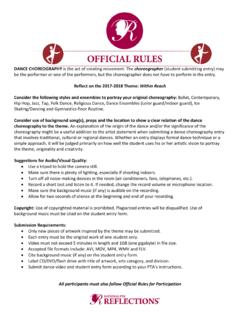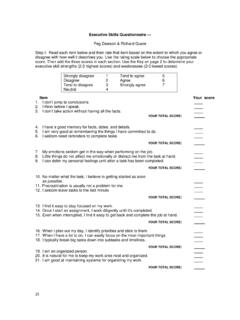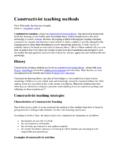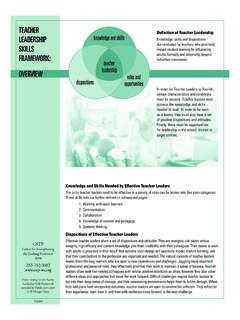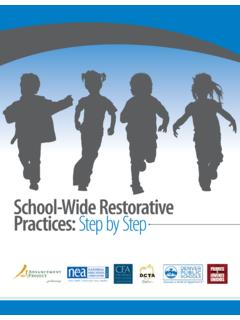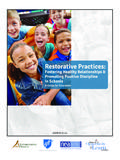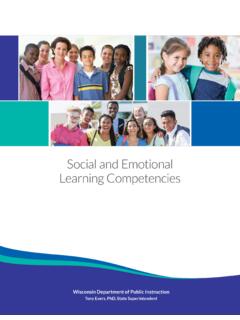Transcription of Hierarchy of Social/Pragmatic Skills as Related to the ...
1 Hierarchy of Social/Pragmatic Skills as Related to the Development of Executive Function created by Kimberly Peters, Age pragmatic Skills EF Development/Tasks requiring EF Treatment Ideas/Strategies 0-3 months Illocutionary caregiver attributes intent to child actions - smiles/coos in response - attends to eyes and mouth - has preference for faces - exhibits turn-taking Development: - behavior is designed to meet immediate needs - cognitive flexibility not emerged - face to face interaction - vocal-turn-taking with care-providers 3-6 months - laughs while socializing - maintains eye contact appropriately - takes turns by vocalizing - maintains topic by following gaze - copies facial expressions - vocal turn-taking with care-providers - facial expressions: tongue protrusion, oh , raspberries.
2 6-9 months - calls to get attention - demonstrates attachment - shows self/acts coy to Peek-a-boo (first true communicative intent) - reaches/points to request Development: - Early inhibitory control emerges - tolerates longer delays and still maintains simple, focused attention - peek-a-boo - place toys slightly out of reach - imitative babbling - imitating actions (waving, covering eyes with hands). 9-12 months - begins directing others - participates in verbal routines - repeats actions that are laughed at - tries to restart play - uses play routines to give & take, build & bash - vocalizes with gesture to protest, reject, request objects or action, call, express feelings, notice/comment, respond to others, refuse * frequency of communicative acts = of free play Development: - Early inhibitory control emerges - tolerates longer delays and still maintain simple, focused attention - singing/finger plays/nursery rhymes - routines (so big!)
3 Where is baby?), peek-a-boo, patta-cake, this little piggy - stacking blocks/knocking them down - waving goodbye - pushing toys/food away; shaking head for no - up with arm raise to be picked up - put objects out of reach for child to reach - vocal play/imitative babbling 12-18 months - imitate routines - imitates other children - uses words to protest/reject, greet/call, respond to others, label/notice, request objects/action, express feelings/wants. - controls behavior of self and others - responds to adult conversational attempts but not contingent - closer to 18 months, uses words to: request information, initiate pretend play, comment/tell info, acknowledge/answer.
4 *Frequency of communicative acts: 5/min of free play Development: - can inhibit certain behaviors and shift to new response sets - some self-monitoring and early ability to identify errors (inconsistent) - impulsive behaviors reflect immature attentional system, distractibility, and undeveloped inhibitory control - model single words for age-appropriate functions - play routines (playing with a doll, pretending to talk on the phone, pushing trucks) - put toys out of reach but in sight for child to point/request with voice - ignore child and wait for child to vocalize to get attention - waving hi , modeling please and thank you (speech or sign).
5 - using no to reject - joint attention activities commenting on what the child is looking at. Modeling pointing/commenting - asking wh questions ( where are your shoes? what s that? where s daddy/sister/brother/mommy? ) 18-24 months - Uses longer utterance (2-3 words) to express intentions: protest/reject, greet/call, respond to others, label/notice, request object/action, express feelings, request information, initiate pretend play, comment/tell info, acknowledge/answer - practices familiar conversational frames and schema (book reading routine, go to restaurant schema). * Frequency of communicative acts: Development: - can inhibit certain behaviors and shift to new response sets - some self-monitoring and early ability to identify errors (inconsistent) - impulsive behaviors reflect immature attentional system, distractibility, and undeveloped inhibitory control - Begins to identify correct vs.
6 Incorrect block constructions (compared to designs) but unable to fix incorrect version. - two- and three-term semantic relations - words for emotions - shared reading activities - what s that? - put toys out of reach, in front of others, for child to label. - verbal turn-taking 24-30 months - please used for polite requests - New intents include: symbolic play, talk about absent objects, misrepresenting reality (lies, teases) - Narratives are heap stories , primarily labels and descriptions - Uses speech to announce intentions - takes two turns in conversation - verbally introduces and changes topics - uses words to express emotion - begins to give descriptions to aid listener - clarifies by repeating - requests clarification - 2 year olds demonstrate knowledge of rules but unable to shift or alter behaviors, demonstrating perseveration - target emotion words - use of imaginative language (think, feel, wonder) - teasing ( that s silly )
7 - requests for clarification - feign lack of understanding: strategies for repairing communication breakdown (ex: providing more information). - experience books for talking about past experiences. - drama activities (dropping things, breaking things, getting hurt, making a mess) - early pronouns 30-36 months - converses in sentences - attempts to control situations verbally Development: - most choices are made by chance are same as 24-30 months - uses polite nice intonation patterns - responds to requests to clarify - apologizes by saying I m sorry - topic continuation near 50% - topics are continued by adding new information - use of language in play increases - narratives are sequences, with theme, but no plot.
8 - ToM: understands that others can want different things (passes a diverse desires task at about 3 years of age). disadvantageous - Unable to delay gratification 36-42 months - takes 4 to 5 conversational turns - uses fillers to acknowledge - begins to shift register with younger children - requests permission - uses language for teasing/jokes/fantasies - consistently uses descriptions to clarify - corrects others - uses pronouns to mark old information - requests using yes/no questions - more flexibility in requesting, including: permission directives ( can ), and indirect requests ( would ). - Direct requests decrease and indirect Development: - increased attention, self-control, concentration, and inhibition, but not mature.
9 - gradual decline in impulsivity, although still present - occasional perseverative behavior - incremental improvements in verbal fluency - gradual improvements in processing speed and accuracy on impulse control tasks - 3-year-olds demonstrate knowledge of rules and emerging ability to shift behaviors, but only for one rule necessary for task success. - What s missing game - elaborated conversations ( tell me about what happened at school today may need to model this type of conversation). - modeling baby talk with younger kids - requests for information and clarification (deliberately obscure input to child/ practice requests for info/clarification).
10 - retelling simple stories - pronouns requests increase. - Primitive narratives: theme and some temporal organization. 42-48 months - has long, detailed conversations - tells two events in correct order - tells story mixing real and unreal - uses pronouns across sentences to mark object - New functions emerge: reporting on past events, reasoning, predicting, expressing empathy, creating imaginary roles and props, maintaining interactions. ToM: understands that others can have different beliefs (passes a diverse belief task by 4 years of age). Skills : - Runs simple errands ( get your shoes from the bedroom ) - Tidies bedroom with some assistance - Performs simple chores and self-help tasks with reminders - inhibits behaviors (don t touch a hot stove, don t run in the street, don t hit, bite, etc.)
